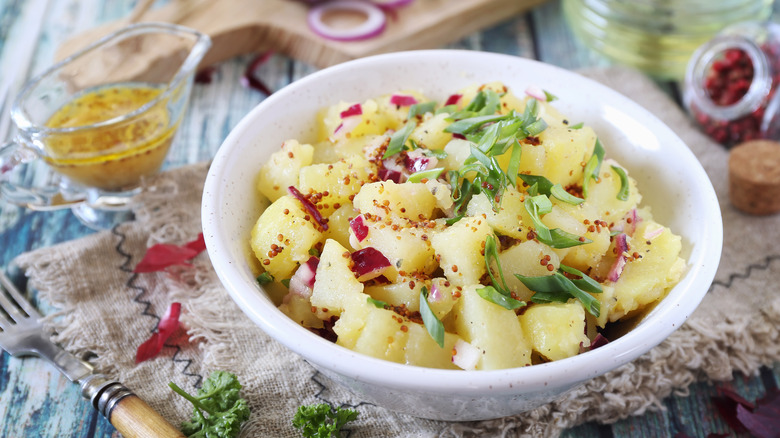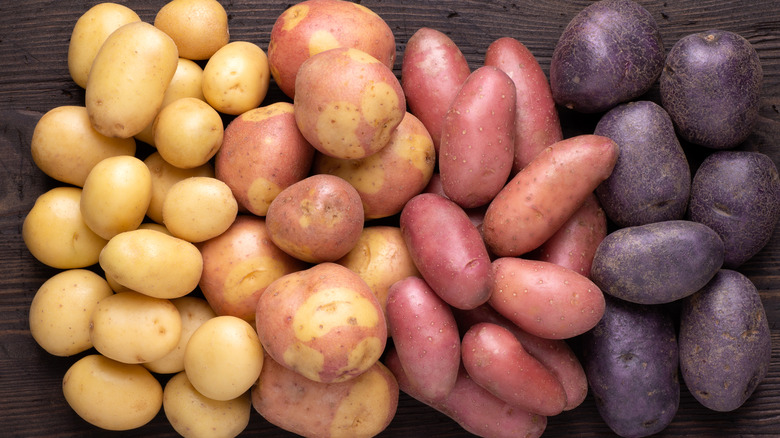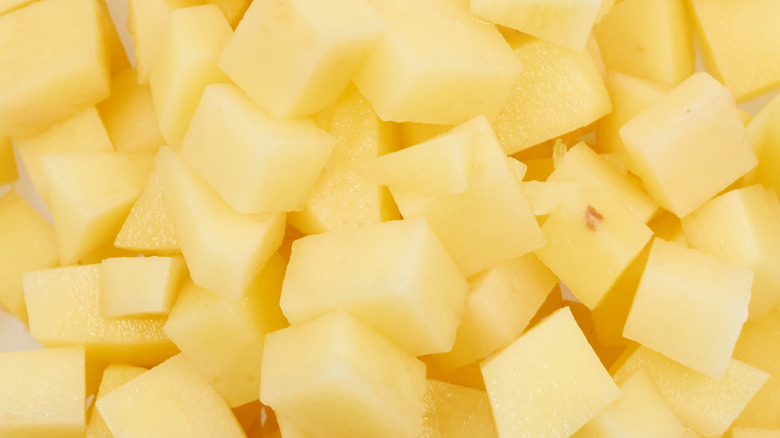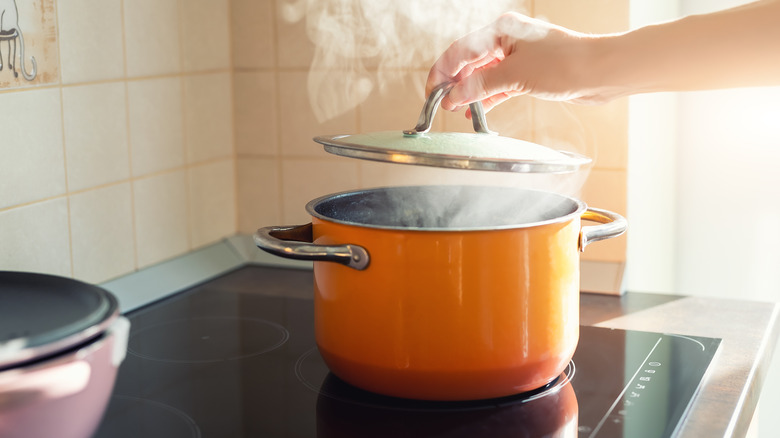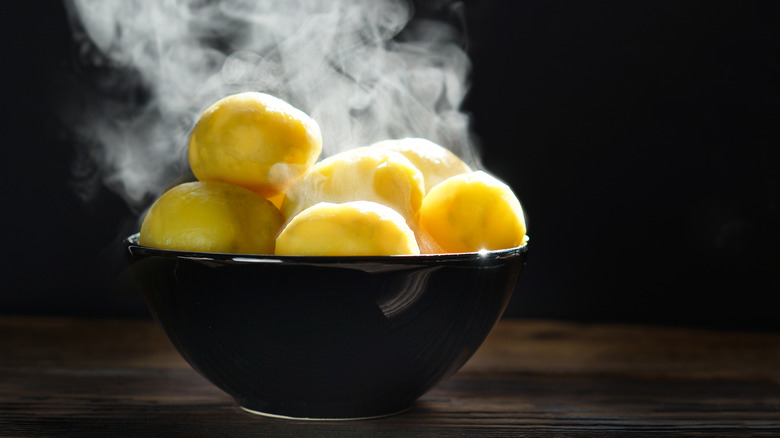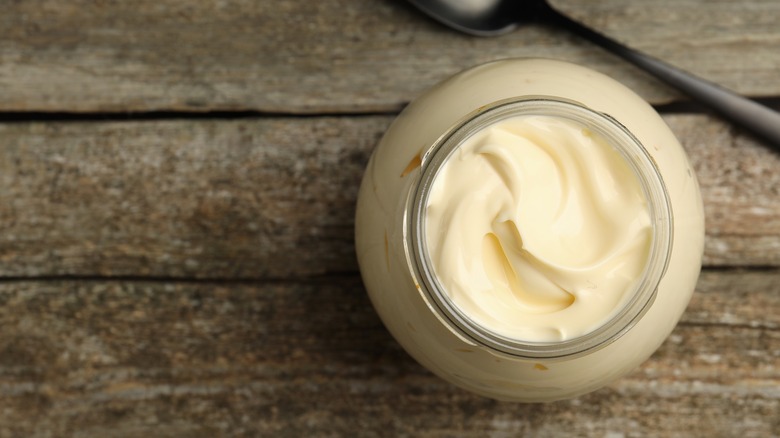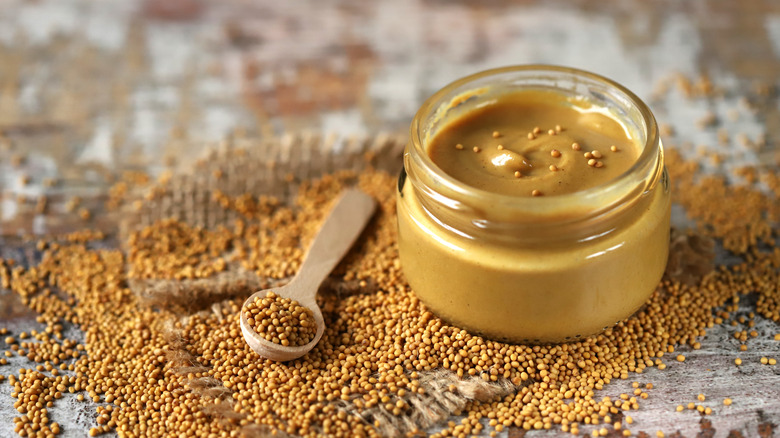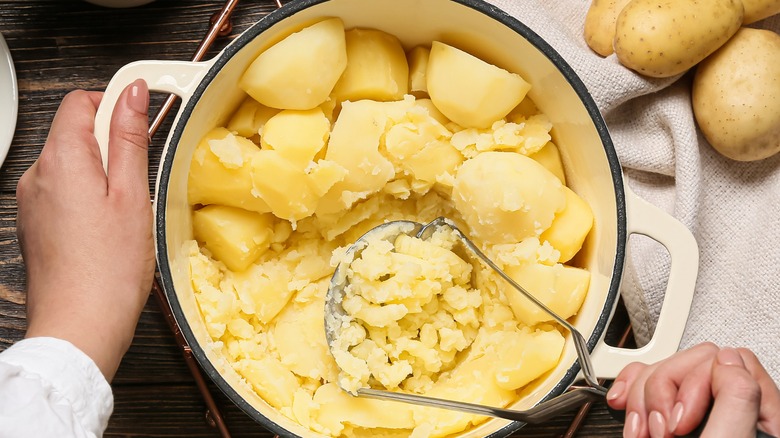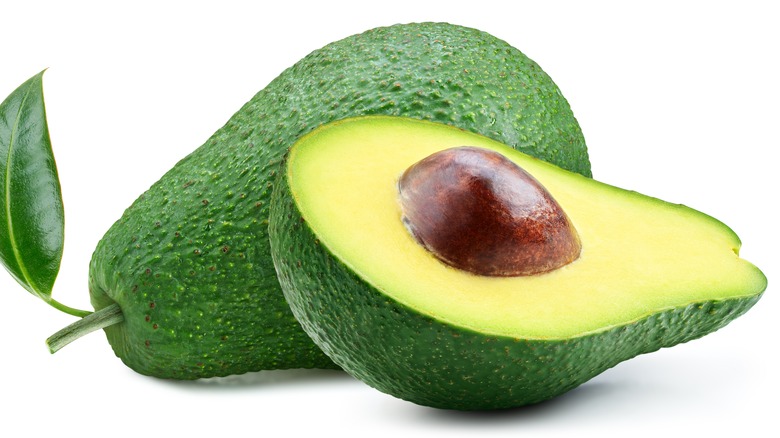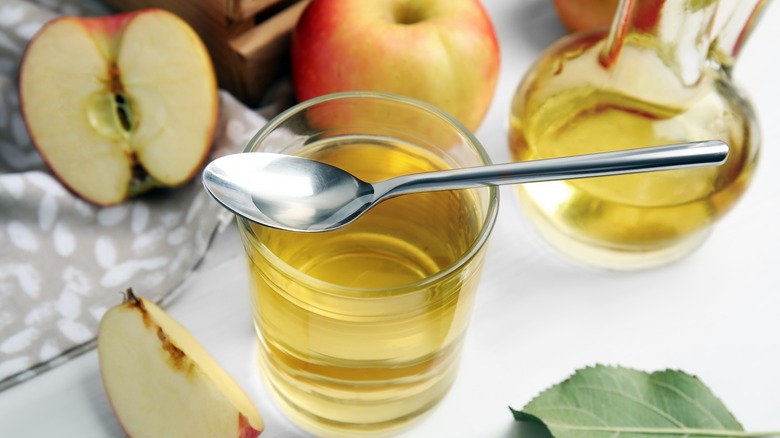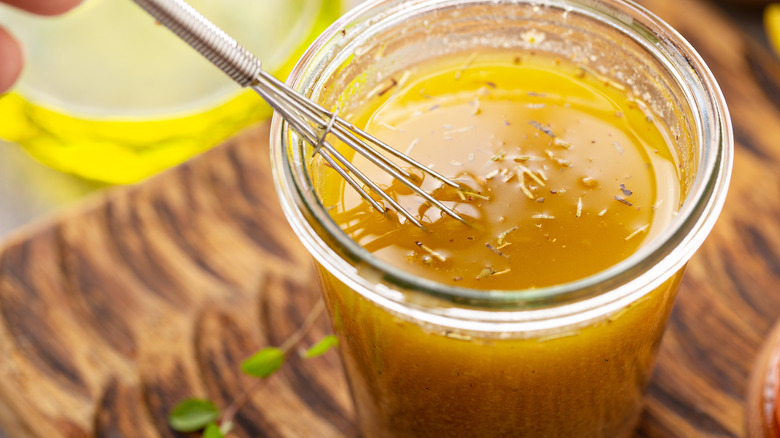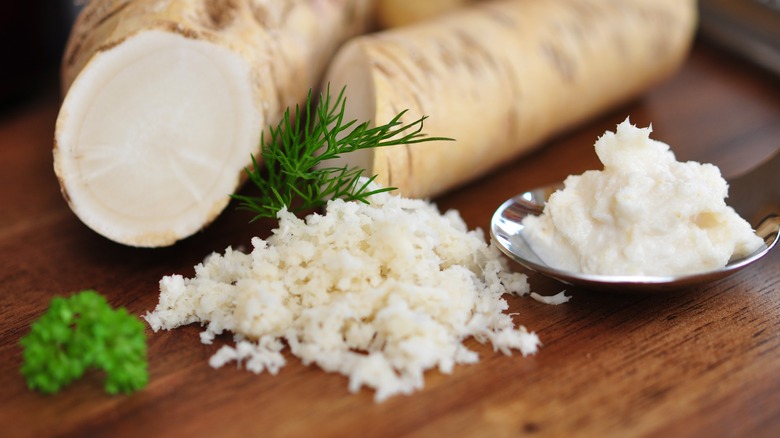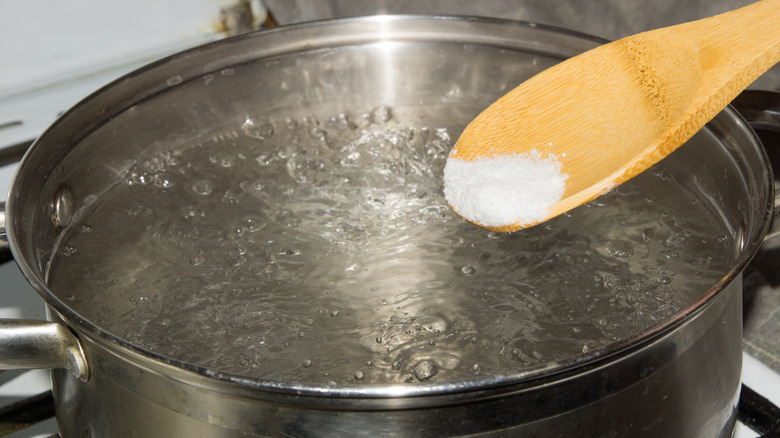The Biggest Mistakes You're Making With Potato Salad
Potato salad: The salad that allows us to eat a whole plateful of carbs while still claiming we're consuming a salad. It's one of the most beloved barbecue side dishes, and since it's so versatile, pretty much anyone can make it according to their preferences. Who doesn't love potato salad? But just because you've made it before doesn't mean you've never made any mistakes. It's all too common to miss a step, pick up the wrong ingredient, or forget to add something to your potato salad. Then, you're left with a gloopy, mayonnaise-tainted mess you don't know what to do with.
We're taking a look at some of the most common mistakes people make when they're cooking potato salad. By avoiding these mistakes, you can make sure that your potato salad comes out perfect every time. Whether you're a russet or a red potato person, avoiding these mistakes can help you take your potato salad-cooking skills to the next level. Keep reading to learn what you shouldn't do the next time you make potato salad.
Using the wrong potatoes
One of the biggest mistakes you can make when you're trying to throw potato salad together is buying the wrong potatoes. If you're not well-acquainted with the different types of potatoes, you may assume that they're all pretty much the same. But when it comes to creating the perfect texture for potato salad, that's unfortunately not the case. Rather, you'll want to pay careful attention to the potatoes you end up grabbing at the store.
According to PureWow, your best bet for potato salad is a waxy potato — this includes fingerling, red, and new potatoes. These work well because they keep their shape, meaning you won't end up with a gloopy texture. However, it depends on what you want out of your potato salad. Some people prefer to use softer, starchier potatoes like russets. These are a great option if you want the potato to fall apart a bit in your salad. Starchy potatoes will result in a more mashed potato-like texture, while the waxy varieties are more likely to stay intact.
Think about what you want out of your potato salad, and pick your potato variety accordingly. Because these potatoes cook at different rates, you're probably not going to want to combine different varieties in your potato salad.
Incorrectly dicing your potatoes
Once you pick out your potatoes and you have them on the counter ready to go, it's time to start peeling and dicing. And if your knife skills aren't great, you're not alone. Take your time so you don't cut yourself, as dicing potatoes can be a tricky task. But while you're dicing, you'll also want to make sure that you're cutting the pieces of potato into even sizes. Per Idaho Potato, if you don't do this, different pieces of potato are going to cook at different rates. You don't want some of your potatoes getting all mushy while the others have barely begun to cook on the inside, so this is something you should keep in mind.
Remember, the smaller you dice your potatoes, the faster they'll cook — just make sure that all of your potato pieces are roughly the same size before you put them in the water. Plus, that means you won't have to do any more cutting after the potatoes have been cooked.
Not starting your potatoes off in cold water
Now, it's time to turn on the stove and start cooking your potatoes. If you're like a lot of people out there, you'll put the water in the pot and wait for it to slowly come to a boil before adding your potatoes. But, as it turns out, that's not the best way to do things if you want your potatoes to be cooked to perfection. According to Maureen Abood, you shouldn't wait for that water to boil. Instead, place your potatoes into the water while it's still cold, and then turn the heat up.
Why should you do things this way? If you place the potatoes straight into boiling water, they're going to have a harder time cooking evenly. The exterior of the potatoes is going to cook right away, while the center of those potatoes will take longer to cook. If you cook the potatoes all the way through, you'll be left with soggy, mushy bits that you probably want to avoid. Simply put a pot of cold water on the stove, add your potatoes, and then turn up the heat. You may just be surprised at how much this can affect the texture of your potato salad.
Over- or under-cooking the potatoes
This one should go without saying, but over- or under-cooking your potatoes is probably one of the most common mistakes that people make when making potato salad. It's easy to do, especially if you don't make potato salad on the regular, as you probably cook your potatoes to a different consistency most of the time. First, you'll want to think about what kind of potatoes you're working with. Waxy potatoes can be cooked for a longer period, but you'll want to try them before you drain them to ensure that they're cooked enough. Starchy potatoes, on the other hand, will break down more easily, so keep checking the texture to ensure that they're not getting too soft during the cooking process.
Per TipBuzz, the amount of time you need to boil a potato largely depends on its size and type, with smaller potatoes cooking faster. If you're in a rush, cutting your potatoes into small pieces will cut down on your cooking time but may increase the risk of overcooking your potatoes.
Undercooked potatoes will be too hard in your salad, and overcooked potatoes run the risk of basically becoming mashed potatoes (though mushy potatoes can sometimes make for great potato salad). Make sure you keep a close eye on the potatoes as they cook so you know when to take them out — in this case, your best bet is to trust your potato salad-making intuition.
Adding mayo too soon
Not everyone likes mayo, but for those who love it, it's an especially important condiment. It's creamy, it's acidic, and it seems to go perfectly with a wide variety of dishes — especially cold salads. Although not all potato salad recipes call for mayo, many (if not most) of them do, so you'll want to know when to add it to avoid making a mess. If you are using a mayo- or cream-based dressing for your salad, it's important to wait for the potatoes to cool before you start dressing them.
What happens if you don't? Well, mayo is sensitive to high temperatures, so the mayo will melt if the potatoes are too hot. Instead of getting that lovely and creamy consistency you're going for, you'll have to be content with oily potato salad that doesn't seem to contain any mayo at all.
Tired of waiting for your potatoes to cool down? You can always rinse them under cool water in the sink if you want to speed up the process, but sometimes, you just have to be patient to get the results you want. Avoid adding that mayo to your potato salad too soon if you truly want that classic, rich, creamy dressing to work its magic.
Using mayo at all
But really, who said you even have to use mayo at all? It may seem like a necessary staple in any good potato salad, but we're here to tell you that you've been brainwashed: There is a ton of delicious potato salad out there that contains absolutely no mayonnaise at all. There are even some solid reasons why you shouldn't use mayo in your potato salad.
First of all, mayonnaise is an egg-heavy ingredient, and if there's one thing we know about eggs, it's that you shouldn't leave them out in the sun unrefrigerated for hours at a time. The fact that we allow our potato salad to sit there and bake in the sun during the backyard barbecue is not a good thing — because that dressing contains mayo, it's really easy for the whole dish to go bad, possibly making anyone who eats it sick.
But even if nobody gets sick from the potato salad, your guests may just not want mayo. It's a contentious ingredient, and vegans (and some vegetarians) don't eat it at all. Don't you want to accommodate your guests that aren't fond of animal products? Finally, adding mayo to your potato salad just makes it so much heavier. If you're looking for a lighter, more refreshing potato salad, you may want to turn to light, lemony vinaigrette over a creamy, rich mayo-based dressing.
Thinking you overcooked your potatoes
So, you think you've cooked your potatoes beyond all recognition? If you're used to potato salad with big, chunky pieces of potato, this could seem like a real problem. After all, you may have been told in the past that mushy potato salad is a major culinary sin. But we're here to tell you that that's not actually the case. As it turns out, when you overcook your potatoes, you're causing them to release a lot of their starch. That starch can stick to the other ingredients, giving you a more coherent salad. In fact, if you're having a hard time incorporating all of that dressing into the salad, overcooked potatoes may just be the answer you're looking for. Of course, not everyone wants this style of potato salad, so if it's not your thing, you should keep a closer eye on your potatoes to ensure that they don't overcook.
Whether you think you've overcooked the potatoes you were going to use for potato salad anyway or you've overcooked potatoes you were going to use for another ingredient, mushy, crumbling potatoes can work well in a potato salad. Don't throw those spuds out! Give this creamier, starchier version of pasta salad a try.
Never deviating from your standard recipe
Do you always make your potato salad the exact same way every time? We all have our favorite recipes, but that doesn't mean you should never switch things up and try something new. For example, why not add some peas and avocado to your potato salad to keep things vegan — and interesting? Your salad may come out greener than you're used to, but you may find that you like it better this way anyway. How about a Korean potato salad made with carrots and cucumbers? It's a great way to get more veggies into your diet.
Of course, you don't have to go completely off the rails when you're trying to change things up. You can always go a simpler route. If you've never added mustard to your potato salad before, go ahead and give it a try. If you always use white onions, opt for red onions or scallions in their place. And for some added crunch, you can sub pickles for the celery you usually use. Potato salad should be treated as a blank canvas — there are so many different options to explore.
Using too much vinegar
If there's one ingredient that will transform just about any salad, it has to be vinegar. Just a splash of the stuff can brighten up any boring flavor profile and give it a zing worthy of salad legend. But unfortunately, vinegar is a powerful ingredient, and if you get a bit too heavy-handed with it, it can have disastrous consequences for your potato salad. Using too much vinegar can make your potato salad too acidic, leaving your guests wrinkling their noses at the intensity of it. Therefore, it's a good idea to try to limit how much vinegar you use in the first place.
But we all know that accidents happen in the kitchen. If your hand slips and you accidentally pour too much vinegar into your potato salad, what should you do? First of all, see if you have a lemon on hand. If you do, grab your zester and add some of that lemon zest to your salad. The bitterness of the peel can help neutralize the acidity in your potato salad, bringing the dish back into balance. Don't have a lemon? No worries. Acid and sugar also balance each other out, so you can simply add a bit of sugar to your potato salad if you can't source a lemon. Just a warning, though; too much sugar, and you'll end up with an even worse problem on your hand. Start slow, and add more sugar as necessary.
Adding too much dressing
This salad mistake is so common, that you've almost definitely made it before, either with potato salad or another salad repertoire. However, it's especially easy to add too much dressing to potato salad. This is because we all know that potatoes soak a lot of that dressing up. Therefore, you may want to add more dressing than is really necessary. Too much dressing can make your potato salad feel too oily or too wet, and all of that extra sauce can interfere with the other flavors you've got going on.
The obvious solution is to add the dressing to your potato salad slowly to ensure that you don't overdo it. But if you accidentally end up with too much dressing anyway, your best bet is to add more potatoes. It may not be convenient to cook and prepare more potatoes, but if it'll save your salad, it's worth the extra time it'll take, right?
Forgetting to add horseradish
You've added your mayo, your mustard, and your vinegar to your potato salad. You taste a spoonful of the stuff, and you suddenly realize: Something's missing. What it is, you don't know, but you do know that the potato salad needs an extra bite; something to keep things interesting. Too many home cooks make the mistake of sending their potato salad out into the world without making sure it has the kick it needs. Luckily, we're here to tell you about an ingredient that can take your potato salad to the next level; horseradish.
This may not be a typical potato salad ingredient for you, but hear us out here. This root vegetable is similar to mustard and wasabi in that it has a distinct heat to it without tasting like chili or other "hot" spices you may think of. It adds a lovely sharp taste to a dish that can otherwise be slightly bland.
Adding horseradish to your potato salad is a solid move, and if you like the taste of the stuff, you should try it. That being said, you should know that horseradish goes a long way, so there's no need to use a ton of it. Adding too much horseradish to your potato salad could make it inedible, as the heat can be intense. Make sure to add it to the dish slowly, tasting between additions to see if it's reached the heat level you prefer.
Forgetting to salt the water for your potatoes
There's one common mistake that people make when preparing potato salad that's easy to fall victim to. Not surprisingly, it comes right at the beginning of the potato salad-making process. Once you've got your potatoes peeled and chopped and your water is boiling, you may think you can throw your potatoes in and wait for them to cook. But by neglecting one important step here, you could be missing out on a ton of flavor. Do you know how you always add salt to pasta water before you throw the pasta in? You're going to want to salt your water for boiling potatoes too.
Potatoes are a very bland food, so they require quite a bit of seasoning to get them to a point where they're as flavorful as possible. That's why you should start imbuing them in flavor early in the cooking process. When you boil your potatoes for potato salad in salted water, it allows some of that salt to soak into the potatoes. That way, they are pre-seasoned before you even get them into the bowl to mix them with the other ingredients. Without the salt, though, you'll suffer from a less flavorful salad. Even if you add salt at the end, that salt will just sit on the surface of the potato and not penetrate into the rest of the vegetable. You'll be amazed at what adding a bit of salt to your potato water can do for your potato salad.
